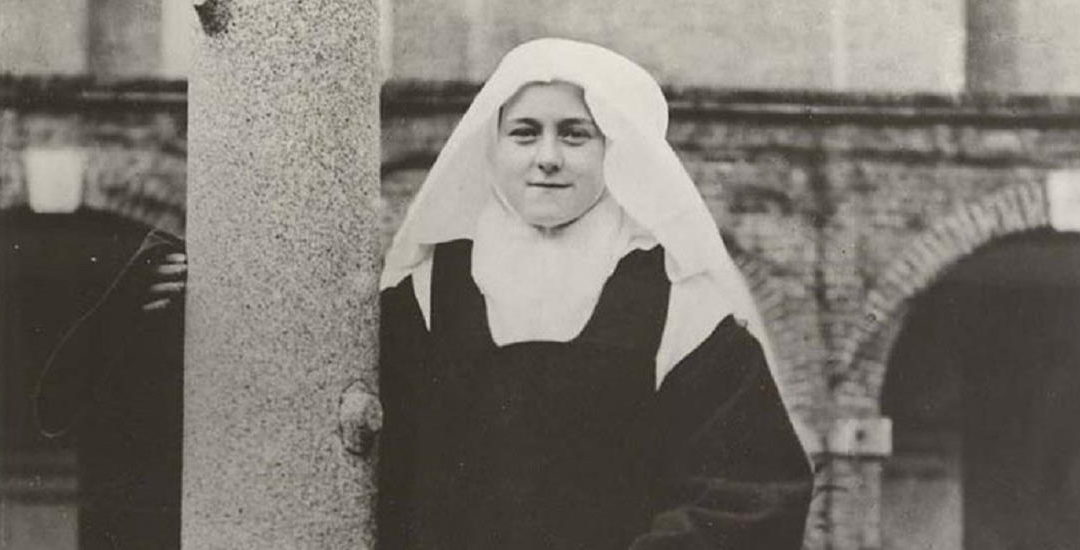by Fr. John A. Hardon, S.J.
Two years before her death, Sister Thérèse of the Child Jesus and of the Holy Face wrote to her aunt, Isidore Guerin: I love to read the lives of the saints very much. The account of their heroic deeds inflames my courage and spurs me on to imitate them. I must admit, however, that I have envied, at times, the happy lot of relatives who had the good fortune to live in their company and enjoy their holy conversation (July 20, 1895).
Two years after her death, the Autobiography (Story of a Soul) she was ordered to write by her Carmelite superiors was published. By the time of her canonization in 1925, over a million copies of the French edition had been sold and translations are now available in all the major languages of the world.
Thus the enjoyment that St. Thérèse found in reading the lives of the saints has been shared by millions of readers of her own life story.
Importance of St. Thérèse
Something of a record was set in the speed with which the Church moved in raising St. Thérèse to the honors of the altar. Her practice of virtue was declared heroic by Pope Benedict XV in 1921. The miracles worked through her intercession were approved two years later by Pope Pius XI, who beatified her in 1923 and canonized her in 1925.
As we read through the pontifical documents issued by these two pontiffs, we find one predominant theme they stress: Thérèse of Lisieux practiced the virtues of spiritual childhood. How important, then, is she among so many saintly persons in modern times? She is very important as a model of childlike reliance on the goodness of God.
This was admirably expressed by Benedict XV in the allocution when he gave Thérèse the title of Venerable.
It is our special desire that the secret of her sanctity may be disclosed to all our children … The more the knowledge of this new heroine is spread abroad, the greater will be the number of imitators giving glory to God by the practice of the virtues of spiritual childhood.
As we reread the papal documents on Thérèse’s virtues, certain features stand out. They may correctly be called the distinctive qualities of spiritual childhood, which the faithful are recommended to imitate. Thus spiritual childhood:
- Knows nothing of spiritual pride. It never glories in whatever graces it receives from God, but acknowledges them as sheer gift of His love.
- Realizes that natural means cannot achieve sanctity. Without prayer, the sacraments, and cooperation with graces received, holiness is a mirage.
- Has no illusions of self-reliance in danger and temptation. Immediate petition for divine help is the only guarantee of being able to overcome the surges of passion or the instigations of the evil one.
- Presupposes a lively faith in God’s existence. In fact, as a person grows in spiritual childhood, there is a keen awareness of God’s presence in everything that touches one’s life.
- Has a practical confidence in God’s power and mercy. Thus the virtue of hope becomes so strong that no matter how humanly impossible the future way seem, there is peaceful trust that God will provide loving care.
- Has confident recourse to Divine providence. It sees the hand of God behind every so-called happening, and believes there is no such thing as chance.
If we look still closer at St. Thérèse’s importance for our times, it becomes even more clear as we see the virus of pride infecting so many people in our day. As the popes are at pains to explain, whatever else the modern world needs, it is a rediscovery of the meaning of Christ’s teaching about becoming like little children. He could not have been more solemn than when He warned us, “Amen I say to you, unless you turn and become like little children, you will not enter into the kingdom of heaven” (Matthew 18:3). This injunction was always necessary but it is crucial today when human achievements in the material world have intoxicated millions with self-conceit and widespread oblivion of God.
Historical Setting
Unlike the great Catholic books of history, the Autobiography of St. Thérèse of Lisieux hardly has a historical setting that occasioned its publication or shaped its composition. Its author lived only twenty-four years, and nine of those were spent in the obscurity of a Carmelite cloister.
Yet there is a deep sense in which we can speak of the historical circumstances in which the book was written. Two French writers, who were contemporaries of St.Thérèse, give us some insight into the devastating ideas that began to plague Christianity in her day. Ernest Renan, the ex-seminarian of Brittany, repudiated the divinity of Christ, portrayed Him as a charming Galilean preacher, and denied that He had ever worked any miracles. Alfred Loisy, a priest from Lorraine, denied that Christ ever founded a Church or instituted any of the sacraments.
No contrast could be more startling than to compare, for example, Renan’s Life of Jesus or Loisy’s Gospel and the Church, with the Autobiography of St. Thérèse. She is writing in a spirit of deep faith, especially faith in the Divinity of Christ, Time and again she speaks to Jesus, as “My God”; whereas Renan and Loisy abandoned the faith they once had, and then studiously contradicted what they had formerly believed.
What should be emphasized, however, is that St. Thérèse’s faith was severely tested. An essential part of her sanctity, therefore, was her courageous profession of faith in spite of the serious temptations against the faith that God allowed her to experience.
The latest publication of Thérèse’s sayings reveals this side of her life which many commentators have overlooked. She was not only plagued with trials about the faith, but she saw the sufferings that God sent her as a providential means of obtaining or restoring faith for unbelievers. “I offer up,” she confided to her superior, “these very great pains to obtain the light of faith for poor unbelievers, for all those who separate themselves from the Church’s beliefs.”
Keeping this in mind will give an entirely new dimension to St. Thérèse’s practice of spiritual childhood. She was an extraordinarily gifted person, with a penetrating intellect. Yet she believed and grew in the faith almost because her faith was so sorely tried by the Lord.
Our Spiritual Focus
From the library of literature on the Little Flower, there are five chapters in her autobiography that give us the core of her spirituality.
- “Towards the Heart of Charity” may be called a personal commentary on the meaning and practice of supernatural love. The author brings out the sobering lesson that our love for God must be shown in deeds. Moreover, the normal and constant opportunity for loving God comes from the cheerful patience we show to the sometimes difficult persons that God puts into our lives.
- “Thérèse as Novice-Mistress” brings out one aspect of God’s providence that we are liable to overlook. As the directress of novices, she learned how differently God dispenses His grace to different souls. It not for us to ask the reason why. After all, He is Master of His gifts, which He distributes to whom and as much us He wills.
- “On Prayer” reveals the lack of sensible consolation that Thérèse experienced for long periods of time. It also shows us something about her that many believers can identify in their own lives. “It’s a terrible thing to admit,” she confessed, “but saying the Rosary takes it out of me more than any hair shirt…Try as I will, I cannot meditate on the mysteries of the Rosary. I just cannot fix my mind on them.”
- “Thérèse and her Brothers on the Mission” gives some explanation of why she was declared patroness of the missions, along with St. Francis Xavier. She recognized that “prayers and sacrifices … are the best help one can give to missionaries.” It was on this basis that the Second Vatican Council made a surprising statement. “Institutes of the contemplative life, by their prayers, penances and trials, are of the greatest importance in the conversion of souls, since it is in answer to prayer that God sends workers into His harvest, opens the minds of non-Christians to hear the Gospel, and makes fruitful the word of salvation in their hearts” (Decree on the Church’s Missionary Activity, no. 40).
- “Her Apostolate of Prayer” provides a simple explanation of a profound truth, that prayer is the most powerful means we have for bringing souls to God. The final reason is hidden in the mystery of the Trinity. But we get some understanding of what this means from the comparison of prayer with a fulcrum. “Give me a lever and a fulcrum,” Thérèse quotes Archimedes as saying, “and I’ll shift the world.” She went on to explain that “the saints have really enjoyed the privilege he asked for; the fulcrum God told them to use was Himself, nothing less than Himself, and the lever was prayer.”
This year is the centennial of the death of St. Thérèse of Lisieux. It comes almost on the eve of the twenty-first century. We can safely say that never before in Christian history has there been more need for an unhappy world, intoxicated with self-love, to learn from her that the only true happiness comes from surrendering one’s heart to the Heart of God.
Father Hardon, S.J. is the Executive Editor of The Catholic Faith magazine.
Copyright © 1997 by Inter Mirifica


